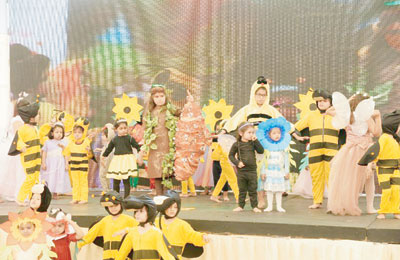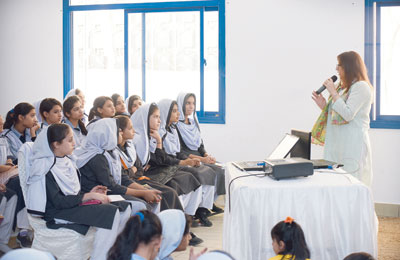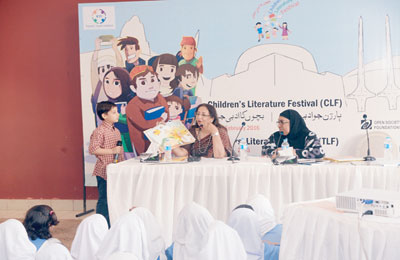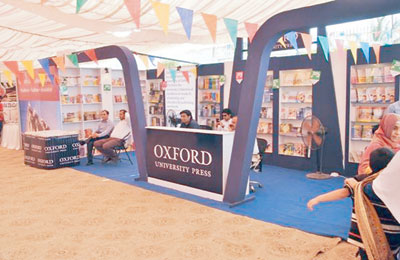CLF – a bird’s eye view
 “There are days you’re going to feel sad, you’re going to feel angry, you’re going to feel scared. That’s nothing you can choose. But you can make stuff. Make films. Draw. Write. It will make a world of difference.”Co-director and co-writer of Inside Out (2015), Pete Docter, was wooing audience with his acceptance speech - he had won the award for Best Animated Feature. It was a touching moment indeed hearing him talk about the need of both recognizing and respecting the emotional lives of our children, especailly as he called out to “anyone out there who’s in junior high, high school, working it out, suffering.” It made me revisit my piece on Children’s
“There are days you’re going to feel sad, you’re going to feel angry, you’re going to feel scared. That’s nothing you can choose. But you can make stuff. Make films. Draw. Write. It will make a world of difference.”Co-director and co-writer of Inside Out (2015), Pete Docter, was wooing audience with his acceptance speech - he had won the award for Best Animated Feature. It was a touching moment indeed hearing him talk about the need of both recognizing and respecting the emotional lives of our children, especailly as he called out to “anyone out there who’s in junior high, high school, working it out, suffering.” It made me revisit my piece on Children’s  Literature Festival (CLF) – held from Feb 26-28 at Dawood Public School (Karachi) – to emphasise on what we are teaching kids these days. Literature Festivals within the array of events being held in our country are all the rage these days, but are they fulfilling their role and satiating the voracious appetite of our young leaders?
Literature Festival (CLF) – held from Feb 26-28 at Dawood Public School (Karachi) – to emphasise on what we are teaching kids these days. Literature Festivals within the array of events being held in our country are all the rage these days, but are they fulfilling their role and satiating the voracious appetite of our young leaders?
Ameena Saiyid was real good with her keynote address in this regard; it struck a chord with all those present and I am pretty sure it will do so with the readers, too. “The Children’s Literature Festival has become part of our lives. This degree of interest and anticipation reflect the need and the importance of books – not just to learn and pass examinations but to enjoy the magic of the written word and read for pleasure.” The managing director of Oxford University Press, Pakistan, further stressed her point saying, “Reading opens windows of the mind to new sights and dreams. [It] is to the mind what exercise is to the body.” Moreover, while acknowledging this branch of KLF as accommodating a wide range of activities of interest for all ages, including parents and teachers, she was quick to point out that the event focused primarily on the children.
 CEO Dawood Foundation, Sabrina Dawood, reiterated the sentiments in her welcome: “Our collaboration with the CLF cements our aim to inspire children to become agents of social change…. We don’t want a child’s education just to be exam-and-classroom oriented.”
CEO Dawood Foundation, Sabrina Dawood, reiterated the sentiments in her welcome: “Our collaboration with the CLF cements our aim to inspire children to become agents of social change…. We don’t want a child’s education just to be exam-and-classroom oriented.”
The fact that there were more than 10,000 children in attendance on the first day and more than 20,000 on the second thronging the school grounds and halls show they’re keen. They are keen to learn. They are keen to have creative experiences. They are keen to share their stories. They are keen for encouragement. The question is how awesome were the sessions in themselves? To what extent did CLF manage to provide, in words of Hina Khawaja Bayat, “images of a happy hour”? I pick four sessions to explore this trail of thought of mine.
Beware – Take Care: an educational programme by Faiza Arshad
How do you teach a child how to attend a door/call? How do you teach him or her, for instance, the reason why they should know the contact numbers to connect to in case of emergency? It could have been a monotonous discussion, boring, and not at all inspiring had not Faiza infused it with her enthusiasm, bringing in everyday examples. It was a smart move because the better the children could relate to it, the better they were able to understand the seriousness of the issue, understand the steps they need to take in order to ensure their safety and growth.
Children in this session learned it’s not always necessary to know their parents’ numbers by heart and that there are different ways these can be kept on hand. Also, where most parents don’t think twice before buying their kids a cellphone, Faiza added to their benefit that it was actually illegal for a child to have one before 18 and if they were using it, especially for Whatsapp, Facebook, and email, then they have to be very careful when adding people. Parents readily assume their kids to be smart, readily introduce them to new gadgets and social media platforms without making these young minds aware of individuals waiting for their chance to harm children; then there are the inappropriate ads that always pop up when the child is playing games online.
But what really made me sit up straight in that session was the students’ reaction when she narrowed down her topic and began with the concept of ‘bullying’, including in this part of the hourly workshop the definition of a bully (“a behaviour that is intentional, hurtful, and repeated by one or more persons”) and the different types of bullying (social, physical, verbal, cyber) that exist in our society. As adults, most of us are confident in and of ourselves and, even as the child brings it to our notice, are inclined to brush such topics under the carpet. Should it surprise me that the faces in the classroom at the moment were anything but blank? A girl genuinely wanted to know how she could deal with it! They recognized the aggressive body language Faiza adopted to  get her message across. There was a resounding ‘yes’ to incidents common in school – “ye tum meri van mein kahan se agai?”; “zara tum mujhy wapsi mein milna”, the instances of tripping, of passing hurtful comments, of excluding others from the ‘gang’, and of mean texts.
get her message across. There was a resounding ‘yes’ to incidents common in school – “ye tum meri van mein kahan se agai?”; “zara tum mujhy wapsi mein milna”, the instances of tripping, of passing hurtful comments, of excluding others from the ‘gang’, and of mean texts.
Labelling them as ‘parasites’, she vehemently stressed that it’s their right to stand up to this culture. A bully who is successful in scaring you today will force you to do a bad deed tomorrow (“aj sirf daraye ga, dhamkaye ga, kal wo ghalat kaam karwae ga for sure”). Moreover, a misconception rife is that it’s only the boys or the younger lot who are the bullies when girls and/or adults, too, commit the same crime; and a mere bystander to the episode will be a bully as well, the sahoolatkaar (facilitator). They were forewarned that most of bullying practices begin as a joke – mein to mazak kar raha tha – and should be reported at that very stage.
And when Faiza talked of the vicious chain of bullying, oh, how they blushed! How many of you recall a moment wherein, caught red-handed, you have felt yourself turned a deeper hue of red? I bet many of my classmates of the moment were feeling the same. Kids bullied at school are often (unconsciously) exhibiting the same traits when interacting in family – “woh cousin meray jesi nahi hai, mein ussay baat nahi kar rahi!” But let’s not forget how they feel themselves when they are at the other end. Shameful. Sad. Embarrassed. A strong communication link with parents and teachers is very important.
Key takeaway: To be agents of change, to not accept bullying at any cost is not restricted to any age or gender.
What do stories tell us
Credit should be given where it’s due and A King for a Day by Rukhsana Khan, which was introduced by Baela Raza Jamil merits it. An award-winning story, it validates her position as a great writer; the intense drama forces one to reflect and become one with the story. Her main character, Malik, is a wheelchair-bound boy who is simply enjoying basant to his heart’s content. The rather ordinary tale symbolised the exhilarating sense of inspiration enjoyed when you battle their fears and end up taking control of the matter, even if this happens to be “on a rooftop in Lahore on sunny winter’s day” while you are eating oranges.
At the same time, Sania Saeed’s animated storytelling session was a hit as far as all those present were concerned. Encouraging their imagination, encouraging them as storytellers in themselves, she did a brilliant job in getting them on-board and have their say, which, predictably, included the nani-versions of popular short stories! It set the perfect stage for the next session, Sidra Iqbal’s How to Dream a Bigger Dream.
It was late afternoon by that time. But it did not put off the young audience. Sure, her being late (it was her birthday, you can excuse her for that!) and the fast-disappearing stock of expired drinks at the canteen meanwhile were disappointing, to say the least, on that hot day. Yet, ever so slowly the room began to fill up and eventually the session began.
 Here, let me just ask you something. What do stories tell us? Tell me what your answer would be if someone asked you just the question, this billion-dollar thought-provoking, unbelievingly simple question? Did you think of their suspenseful nature, that you don’t know what will happen on the next page or the next line and the next when you pick up an interesting title? Did you think of the awe you are in of the protagonist (it’s usually the protagonist) as it keeps moving forward despite odds and despite negative circumstances and people barring it? Then, kudos to you as it was to the kids who guessed where Sidra was heading to with her opening question.
Here, let me just ask you something. What do stories tell us? Tell me what your answer would be if someone asked you just the question, this billion-dollar thought-provoking, unbelievingly simple question? Did you think of their suspenseful nature, that you don’t know what will happen on the next page or the next line and the next when you pick up an interesting title? Did you think of the awe you are in of the protagonist (it’s usually the protagonist) as it keeps moving forward despite odds and despite negative circumstances and people barring it? Then, kudos to you as it was to the kids who guessed where Sidra was heading to with her opening question.
All too familiar with the phrase “yeh possible nahi hai” that individuals hear all their lives, at home, schools, and later on, she asked them what they wanted to be when they grew up. A brigadier, doctor, a teacher, a designer, an airhostess, a cricketer, an engineer, a scientist, this is what they dreamt of! She was right to say that the power to turn their dreams into reality and create their own destiny was in their hands. It wasn’t just “the images in [their] mind”, directing them. There were two essential points they had to remember in this case: (a) the determination to feel at the moment (“jab chotay hotay hain sab cheez possible lagti hai”); and (b) the feeling they would get when their dream is accomplished (“jab sab -i.e. ghar kesa hoga, gari kesi hogi, ab mein doctor ban gai etc. - hojaega, tab aap kese feel krogay”). She termed the latter “the power turbo” to achieve whatever their hearts desired. You would, in fact, instil magic in your dream if you do not consider any ifs and buts along with it such as “ye kesay hoga”. Something similar happened to her in her own childhood just like it was in Paulo Coelho’s The Alchemist – “And when you want something mething, all the universe conspires in helping you to achieve it”. As a girl who did not have high self confidence to begin with, her ability to dream, to believe in it, and to work for it made her into who she is now. According to her, it is never a straightforward journey; there are some terms and conditions. First, there will be the ‘beginner’s luck’, whence the nature would lure you in with consecutive successes. Next in will be a test-phase wherein the nature siphons away the undeserving from the lot. This is the make-or-break stage where the way you deal with challenges and problems thrown your way determines your winning streak.
Key takeaway: If you stick to your dream, then this world is your oyster. If you want to be called a winner, then you’ve to pick yourself up and go on, you’ve to remember to breathe and stay in present rather than the past or the future, you’ve to say out practice daily the two most powerful words in the universe that are “I AM”.
The writer is a member of staff and can be reached at shermeenzuberi@hotmail.comCOVER STORY
SPEAKERS ON CLF
From a teacher to becoming a Vice Principal, she has been associated with Foundation Public School for sixteen years. She believes that all children can be successful learners.
“It was actually my aunt, Tina Sani, who enocouraged me to attend CLF as a speaker this time and, you know, put my knowledge to good use. Events like CLF are truly very essential. I personally focus on each child, and my idea of making a difference is a child who successfully adopts in real life whatever he learnt during the event even if it’s just one thing. Since, safety and security are the buzz words every child hears but hardly understands or relates to as something they need to do for themselves, my inspiration for the topic was to empower them with simple, smart ideas. I felt I had so much to share with students and teachers that every passing moment had to be spent on grooming them to achieve their best potential. I think this is the need of the hour; plus, the topic is age-friendly. Overall, it was a wonderful experience!”
A member of the International Storytelling Network, she is an award-winning Pakistani-Canadian children’s author and storyteller whose work specifically includes ‘tales of diversity’.
“Be true to yourself and if you are different it does not matter as long as you are in touch with your special calling that nature has endowed you with – this is how I learnt to become comfortable with my colour, being, and more in the West.”
Commended for many a role she has performed in theatre and on television screens for well over two decades, she is known to be particular about the story of any project that she takes up, ensuring it’s a role she would like to stand by.
“We are losing the tradition of storytelling; storytelling is the best way of transferring our traditions, our values, without hammering them into our children’s head. It will be very sad if our children are not able to experience that. I think Children’s Literature Festival has played a very important role in not just the children, but in parents, too.”
The first one from our country to have won English Speaking Union’s International Public Speaking Championship (1999), she has since then managed to rope in several nominations as a Youth Ambassador; is also as a media anchorperson and Founder Managing Director of Statuspro 360 Inc., her own PR firm.
“It was the second time I attended it and the energy of the young people there was very, very inspiring! CLF is a fantastic experience. There are few homes where kids see their elders reading and the only books that they have access to are the school texts. Both of this makes it difficult for them to like literature. If one is to improve this situation, we need more events like CLF; we need to find more relevant content, which moreover, is according to local context.”
Her message for the youth is to “read more because it feeds your imagination. Also, opportunities har ek ko milti hain, we don’t indulge in them. We overlook it. My own experience was just a competition; I was the one who took it seriously. So, be inspired and give it a shot.”